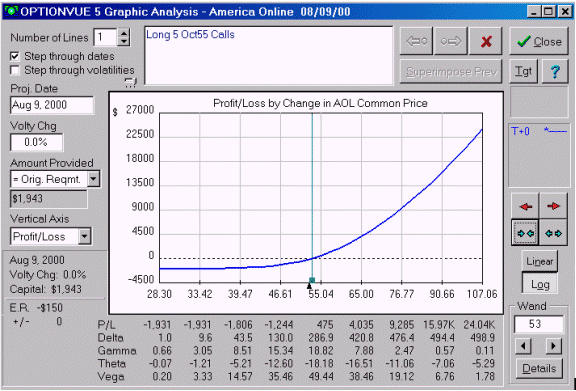Choosing the Best Option to Trade
An option is a beautiful thing. Buy one. When you’re correct about the direction of the market, gains are unlimited. When wrong, losses are limited.
Sure, time decay works against your position while the underlying goes nowhere (or takes an excursion in the wrong direction first), but this is an acceptable cost if the option is reasonably priced. (That is, implied volatility is at normal or below normal levels.) As I have said many times, there is nothing wrong with buying a reasonably priced option. An option purchase has an amazing risk/reward curvature.
Prior to expiration, an option’s profit/loss profile is a gentle curve, bending the most in the middle, and flattening in either direction – kind of like a bent steel bar. On one end, the curve flattens out into a 45° angle. This is when the option is deep in-the-money. In the other direction, the curve approaches a 0° angle. This is when the option is deep out-of-the-money. See Figure 1 for the familiar profile of a call option purchase.
 Figure 1
Figure 1
An at-the-money option is at its maximum inflection point. From there, as the underlying moves in the desired direction, your position makes money faster and faster. For example, the first point the underlying moves in your direction, the option gains perhaps a half-point. The next point the underlying moves in your direction, the option gains perhaps 5/8 point. And so on, until, when the option is deep in-the-money, it moves point-for-point with the underlying.
On the other hand, if the underlying moves against you, your position loses money slower and slower as the curve flattens out.
So, how does the trader decide which option to buy? Here is some advice that may help:
Unless you enjoy living on the edge, buy an option with at least twice as much life as you feel you’ll need. That way, a countertrend day won’t make you nervous. How many times have you been anxious when holding an option with less than two weeks of remaining life and the market goes the wrong way for one or two days? You’re probably wondering, “Has the market reversed? Was yesterday’s price the best I was ever going to see? I wish I could have that price back now! I think I’d sell just to be safe. Yes, but I can’t have that price back. I’ll have to accept that the market is what it is now. Should I sell now?”
Stress is bad for trading. It leads to bad decisions. Use an option with plenty of life, and you can see the market through its little wiggles without stress.
How far in or out of the money you buy is a safety/leverage trade-off. For more safety, buy an in-the-money option. For more leverage (and greater risk), buy an out-of-the-money option. I would never buy a far out-of-the-money option unless I knew something very special about the stock (and I never do). In fact, I recommend always buying options at or around the money, so that you’re near the option’s maximum inflection point. That way if the underlying heads the wrong way right out of the starting gate, it’s hurting me less and less as it goes, but if the underlying heads the right way, it’s helping me faster and faster as it goes.
